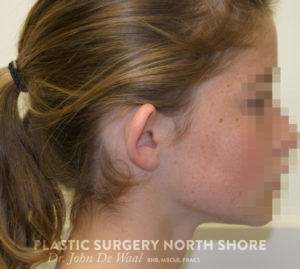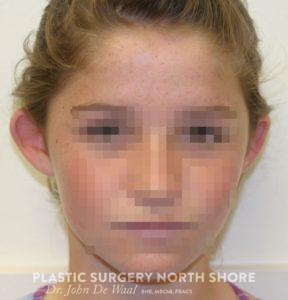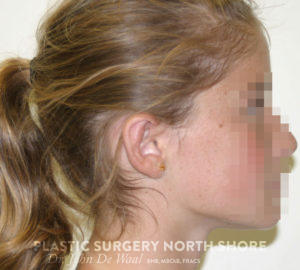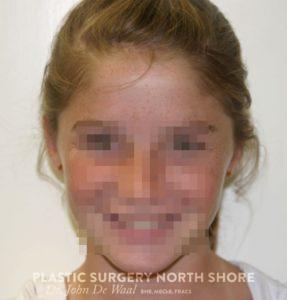Prominent Ear Correction (Otoplasty)
Prominent ears are a relatively common condition. Many children and adults can feel self-conscious or uncomfortable with the shape, size or position of their ears. For children especially, prominent ears can be a source of distress, particularly if they’re experiencing teasing about the physical appearance of their ears.
Usually, ears are prominent and appear to ‘stick out’ due to two reasons:
- A large concha – the hollow of the ear is very deep and effectively ‘lifts’ the ear off the side of the head
- A lack of an antihelical fold – looking at an ear side on you will see that it has a fold that ‘turns the ear backwards’. Some people lack this fold and hence the ears ‘stick out’.
Fortunately, we can easily correct prominent ears using a straightforward surgical technique: otoplasty, or ear correction surgery.

What is an otoplasty?
Otoplasty, also known as prominent ear correction surgery or ear pinning, is an effective surgical fix for prominent ears. We bring the ears into improved proportion with the rest of the head through sculpturing and buried stitches.
Otoplasty is commonly performed during childhood around age seven. Around this age, it is safe to operate as the ears have reached almost 90% of their adult size. However, people of all ages can undergo the procedure and reclaim self-confidence about the appearance of their ears.
The surgery typically takes about two hours and the correction is permanent, giving the ears a natural appearance for life.
Benefits of ear correction surgery (Otoplasty)
Otoplasty surgeries significantly improve the appearance of prominent or abnormally shaped ears.
Beyond positive aesthetic changes, the real benefit is that you will feel less self-conscious about how your ears look. Many of our patients feel a sense of relief and renewed confidence almost immediately after their surgery.
It is important to ask questions and feel that you understand the otoplasty procedure, especially if the patient is a child who might be feeling nervous about the surgery.
Treatment is relatively straightforward and involves correcting one or both of the concha or antihelical fold. We make an incision behind the ear where it is least visible, and remodel the cartilage (the firm tissue under the skin that gives the ear its shape). Since every patient is unique, our technique for ear pinning surgery will vary based on the type of correction required.
If the ‘concha’ is too deep, we may remove some cartilage. If the fold of the ear is absent or underdeveloped, then we produce a fold by manipulating the cartilage into the desired shape.
We can perform otoplasty for ears that stick out using local or general anaesthetic. The procedure only takes about 45 minutes per ear. Most adults have an otoplasty under local anaesthetic, while most children have it under a general anaesthetic.
Dr de Waal is an experienced specialist who takes care to ensure that bruising is minimal and any scarring is hidden. Recovery from Otoplasty ear pinning surgery is typically quick. Most patients will not require much time off work or school.
Following the operation, we apply a large head bandage to hold the ears in their new position and to minimise swelling and bleeding. We can remove the bandage 5-10 days later.
We will give you a ‘headband’ to wear at night over the 3-4 weeks following the otoplasty. This will help your cartilage ‘set’ into its new position.
After your operation, you can expect*:
- Release from the hospital after a few hours
- 5 – 7 days of rest and low-impact activities
- 3-4 weeks until bruising and swelling disappeared
- 4-6 weeks until return to strenuous activities
- 12 weeks until final result
*recovery times are approximate and dependent on the individual and their procedure.
Implications for any surgery are typically unlikely with proper care. However, like all surgeries, there is always a risk of bleeding, infection and bad reactions to anaesthesia.
As otoplasty for prominent ears is a common and relatively safe procedure, usually risks and complications are minimal, though occasionally keloid scars have been noted.
Ear pinning surgery risks:
- Bleeding can sometimes occur after your operation. It’s important to minimise this if it occurs, as build-up can cause thickening of the ear.
- Infection is a risk of all operations, however with early and correct treatment this is only ever a minor issue.
- Scarring as a result of surgery is common, however we do ensure that otoplasty scars are very well-hidden.
- Numbness of the top of the ear
- Tenderness
Should I expect pain after otoplasty?
We always use anaesthetic during surgery, so you will initially be pain-free. However, this wears off after around four to six hours. After this, you may experience mild discomfort.
You may also experience some swelling and itching; however, this is generally minimal and easily managed with painkillers.
Before any procedure, Dr de Waal will discuss any potential risks and make sure that you fit the profile of a healthy otoplasty candidate.
Traditionally the youngest age at which the ear pinning operation is performed is age 6 or 7 years.
This is because:
- The ears have reached almost 90% of their adult size at age 7
- At a very young age the ear cartilage is quite soft and is less able to hold the new shape into which it is moulded at the time of operation
- It is usually not until the child reaches school that they are aware that their ears are prominent. Because they need to wear a head bandage, it is preferable that the child is co-operative and this is much easier when they have reached an age of relative understanding
These are generally safe rules to follow, however, each patient is treated on a case-by-case basis.
It is now recognised in young soft ears that if the ear can be held in a certain position long enough, the ear will set in this position. This enables the use of ear ‘moulds’ in infants under 6 months and the use of simpler operation techniques to achieve the desired ear shape in young children.





